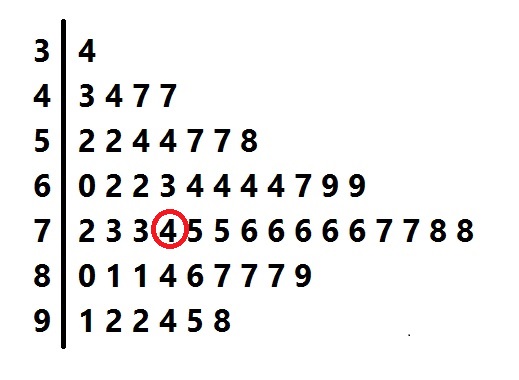All SAT II Math II Resources
Example Questions
Example Question #491 : Sat Subject Test In Math Ii
Identify the range of the numbers:
The range is the difference between the largest and smallest numbers.
The largest number is:
The smallest number is:
Subtract both numbers.
The answer is:
Example Question #1 : Range
Determine the range of the numbers:
The range is the difference between the largest and smallest numbers.
The largest number is 50, and the smallest number is 3.
The answer is:
Example Question #22 : Data Analysis And Statistics
Find the range given the following numbers:
The range is the difference between the largest and smallest numbers.
The largest number is 15.
The smallest number is 
Subtract the two numbers.
The answer is:
Example Question #2 : Range
Determine the range:
The range is the difference between the largest and smallest numbers.
The largest number is 15.
The smallest number is -5.
Subtract both numbers.
The answer is 
Example Question #491 : Sat Subject Test In Math Ii

The distribution of scores for a test given to a large group of students is represented by the above box-and-whisker plot.
To the nearest whole number, what was the standard deviation of the scores?
Insufficient information is given to answer the question.
Insufficient information is given to answer the question.
A box-and-whisker plot gives the lowest and highest scores and the three quartiles (including the median), which depend on the relative position of the scores. The standard deviation of the scores depends on the scores themselves, which are not reflected in the diagram. The question cannot be answered from the box-and-whisker plot.
Example Question #1 : Quartiles And Interquartile Range

Above is the stem-and-leaf display for a group of test scores. Give the interquartile range of the scores represented.
The interquartile range is the difference between the third and first quartiles. To find these quartiles, first find the median of the scores. There are 53 scores represented, so look for the score in position

As can be seen in this diagram, the score is 74.

The first quartile is the median of the lower half of the scores - that is, the lower 26 scores. Since 26 is even, the median is the mean of the scores in positions 

As can be seen in this diagram, these scores are 60 and 62.

The first quartile of the scores is therefore
The third quartile, similarly, can be found by finding the mean of the 13th and 14th elements in the top half of the scores:

As can be seen in this diagram, these scores are 81 and 81, so the third quartile is 81.
The interquartile range is the difference:
Example Question #492 : Sat Subject Test In Math Ii

Above is the stem-and-leaf display for a group of test scores. What score is at the third quartile?
To find the third quartile, first find the median of the scores. There are 53 scores represented, so look for the score in position

As can be seen in this diagram, the score is 74.

The third quartile is the median of the upper half of the scores - that is, the higher 26 scores. Since 26 is even, the median is the mean of the scores in positions 


As can be seen in this diagram, both of these scores are 81, so the third quartile is 81.
Example Question #491 : Sat Subject Test In Math Ii

Above is the stem-and-leaf display for a group of test scores. What is the first quartile?
To find the first quartile, first find the median of the scores. There are 53 scores represented, so, 53 being odd, look for the score in the center. This is the score in position

As can be seen in this diagram, the score is 74.

The first quartile is the median of the lower half of the scores - that is, the lower 26 scores. Since 26 is even, the median is the mean of the scores in positions 

As can be seen in this diagram, these scores are 60 and 62.

The first quartile of the scores is therefore 
Example Question #494 : Sat Subject Test In Math Ii
Consider the following numbers: ![[5, 8, 1, 4, 8, 9, 1]](https://vt-vtwa-assets.varsitytutors.com/vt-vtwa/uploads/formula_image/image/1021573/gif.latex)
The first quartile is Q1.
Reorganize the numbers in chronological order.
The Q1 is the median of ![[1,1,4]](https://vt-vtwa-assets.varsitytutors.com/vt-vtwa/uploads/formula_image/image/1021575/gif.latex)
The answer is:
Example Question #491 : Sat Subject Test In Math Ii
Two dice, one red and one blue, are altered. The red die comes up a "1" 



Insufficient information is given to solve the problem.
11 to 3
6 to 1
8 to 3
23 to 5
Insufficient information is given to solve the problem.
A "2" can only be rolled on the two dice with a double "1";, a "3", with a "1-2" or "2-1", and a "4", with a "1-3", a "2-2", or a "3-1". This makes six favoriable rolls. To answer the question, we must know the probabilities that the red die will come up "1", "2", and "3"; we must also know the same for the blue die. We know the probabilities for "1" and "2" for each die, but not "3". Therefore, insufficent information is given in the problem.
Certified Tutor
All SAT II Math II Resources

![[-5,-7,12,-12,19,-3]](https://vt-vtwa-assets.varsitytutors.com/vt-vtwa/uploads/formula_image/image/936049/gif.latex)









![[6,9,7,10,50,3]](https://vt-vtwa-assets.varsitytutors.com/vt-vtwa/uploads/formula_image/image/1010725/gif.latex)







![[7,8,-10,15,-20]](https://vt-vtwa-assets.varsitytutors.com/vt-vtwa/uploads/formula_image/image/1031429/gif.latex)







![[ -3,-5,10,15,-3]](https://vt-vtwa-assets.varsitytutors.com/vt-vtwa/uploads/formula_image/image/1021593/gif.latex)






























![[5, 8, 1, 4, 8, 9, 1]\rightarrow [1,1,4,5,8,8,9]](https://vt-vtwa-assets.varsitytutors.com/vt-vtwa/uploads/formula_image/image/1021574/gif.latex)




